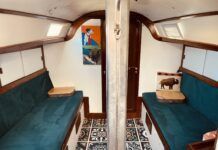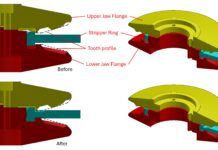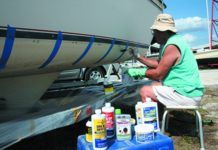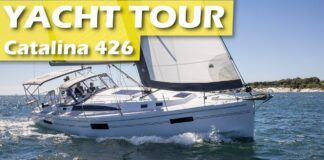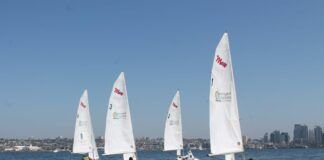Globe-Trotting Morgan I just completed a family, 17-year, and 50,000-mile circumnavigation onboard
In addition to 17 years at sea, Hippos Camp has endured-unscathed-36 hours in the 1994 Queens Birthday storm in the South Pacific, and dealt with the vertical seas of the Agulhas current in 40 knots of wind in the Mozambique Channel.
The gelcoat and nonskid on our 22-year-old boat are original and look almost new after polishing. The Perkins 4-108 has 5,700 hours and runs like a Swiss clock.
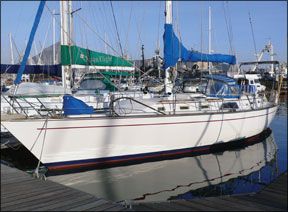
288
The Morgan 43 is also a remarkable performer in light air. We crossed the Bay of Bengal at an average speed of 4 knots with never more than 8 knots of wind. This is, in my opinion, a real asset.
The Morgan 43 was made by Morgan Yachts before it was bought out by Catalina. I think Morgan made 77 43s, and a few more 44s before it stopped.
Dominique Eustache
Hippos Camp, Morgan 43
Puerto Rico
More on the Classics
I thoroughly enjoyed reading “30-foot Classics” (February 2008). I am currently boatless, but do plan to purchase another boat. I had a Sabre 28 that I enjoyed thoroughly and took on several trips to the Bahamas and the Florida Keys. I sold it because my significant other and I plan to sail farther afield, to South America and perhaps a trans-
Atlantic. Although the Sabre 28 was very well made and a great boat to sail and use for short trips, I didnt feel it had the accommodations (e.g. tank capacities and storage room) for an extended offshore sail.
Reading the advice of bluewater sailors such as Hal Roth, and talking to offshore sailors I know, I am of the opinion that the optimum boat for a couple sailing offshore is (arguably) in the 34- to 36-foot range. It would be great if you could review a few classics in that size range.
Gene Talbot
Fort Lauderdale, Fla.
Former
Practical Sailor editor and author of the book “Heart of Glass” Dan Spurr will present several viable contenders in his next report “Recession-proof 37-footers.” The list of boats profiled in that upcoming article are the Allied Princess, Bristol 35.5 C, C&C Landfall 38, Endeavour 37, Freedom 36, Niagara 35, ODay 37, S2 11.0, and Tartan 37. The field was deliberately narrowed to include similar boats-note there are no double-enders-and although the boats were not selected strictly for their cruising capabilities, you may find one among them that fits your needs. One list of potential cruising boats weve referred to in the past is posted on John Neals Offshore Cruising Expeditions website: www.mahina.com/boats.html.Mattress Liner
Some time ago, we bought a synthetic mat-like material that we put under our V-berth. It completely stopped the underside from getting soaked. This is not the Froli system, which
Practical Sailor featured in the April 15, 2005 issue. I have looked online, but cannot locate the source of the product we use. Do you have any recommendations?Paul White
Rockport, Maine
The product you describe sounds like Hypervent, one of three featured in the Oct. 15, 2004 issue, along with the results of the
Practical Sailor mattress tests. You can find this product online atwww.hyperventmarine.com.
PVC Dinghy Cleaner
Your article on Hypalon inflatable boat cleaners (March 2008) was great. How do the cleaners fare on PVC? I own a Zodiac; it needs a good cleaning, but items like Spray 9 just don’t do the trick.
Greg Azia
Formula PC 31
New London, Conn.
According to the folks at Zodiac, for most cleaning jobs, a soft scrub brush with a mild bleach-and-water solution works well for regular cleaning. They advise following this with a coating of 303 Protectant to protect the fabric and repel dirt. We are testing 303 and other protectants like it. If you need deeper cleaning, try one of the recommended cleaners from our test, such as NRS Inflatable Boat Cleaner. For those in search of a RIB to clean, see our review of 10-footers starting on page 5.
Cleaning PFDs
How do I clean PFDs? My sailing club has many members who use varying brands of sunscreen. Only the top and front of the clubs PFDs (made by Kent) show black
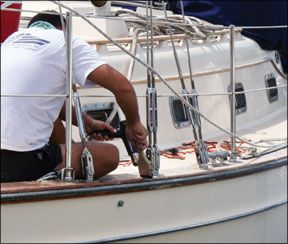
288
soil marks. We tried Simple Green; didnt work. RollOff cleaned them but also took off the orange color. We don’t want to buy new PFDs every year just for hygiene and appearance. Any suggestions?
Ed Schroeder
Sail Chicago
Chicago, Ill.
Deep stains to nylon are often impossible to remove without harming the fabric. Kent recommends using a mild soap-and-water mix followed by a thorough rinsing in fresh water and allowing the vest to drip dry completely away from direct sun or other direct heat source. Others suggest warm water. Do not use bleach. We welcome reader suggestions on this.
Varnish Remover?
I recently bought a Glen-L Fancy Free sharpie that needs restoration. It has lots of exterior wood that has varnish. Has
Practical Sailor done a review of chemical varnish removers?Dave Null
Via e-mail
Funny you should ask: Associate Editor Ann Key is currently removing several layers of two-part varnish from a 1981 Cape Dory 25. Shes using
an inexpensive heat gun, very sharp scrapers, and patience. But this process takes some dexterity. Its easy to dig an edge and leave scraper hieroglyphs in the wood. Rounding the edges of a scraper or putty knife on a grinding wheel can help prevent the problem. Aside from the mess a stripper leaves and the risk of getting stripper on adjacent painted surfaces, there is a concern that any chemical residue could hinder subsequent wood coatings from adhering properly. The Epifanes website, www.epifanes.com, has a fairly complete description of the process that has served us well in the past. However, if a lot of varnish is to be removed, a stripper may be worth considering.The maker of one of our top bottom paint strippers (Soy-Strip, April 2008), Franmar recommends its Soy-Gel product to remove varnish. (Soy-Gel basically is a less-expensive Soy-Strip.) Soy-Gel removes all sorts of coatings, including teak oil and two-part polyurethane, according to Franmar. The two-part varnishes will be tougher to take off than oil-based coatings, and if the two-part has a solids count higher than 40 percent, Soy-Gel may not take it off at all. If using Soy-Gel or Soy-Strip on teak, don’t leave it on very long as it will fur teak. Technical editor Ralph Naranjo suggests Interluxs Interstrip 299E. Paint and varnish removers do not require as much skill as wielding a heat gun and scraper. Chemistry does most of the work, and it is less invasive, but be sure to keep the stripper off adjacent painted surfaces and do a test spot.
Corrections
The contact number for Hart Tank Tender tank monitoring system
(May 2008) is 253/858-8481.
The article on eco-friendly cleaning products (“Practically Green,” May 2008) did not mean to imply that aqueous hydrogen chloride and hydrochloric acid were different chemicals. Cleaners containing hydrochloric acid that were designated as less “ferocious” in that article contained significantly lower concentrations of acids.

















